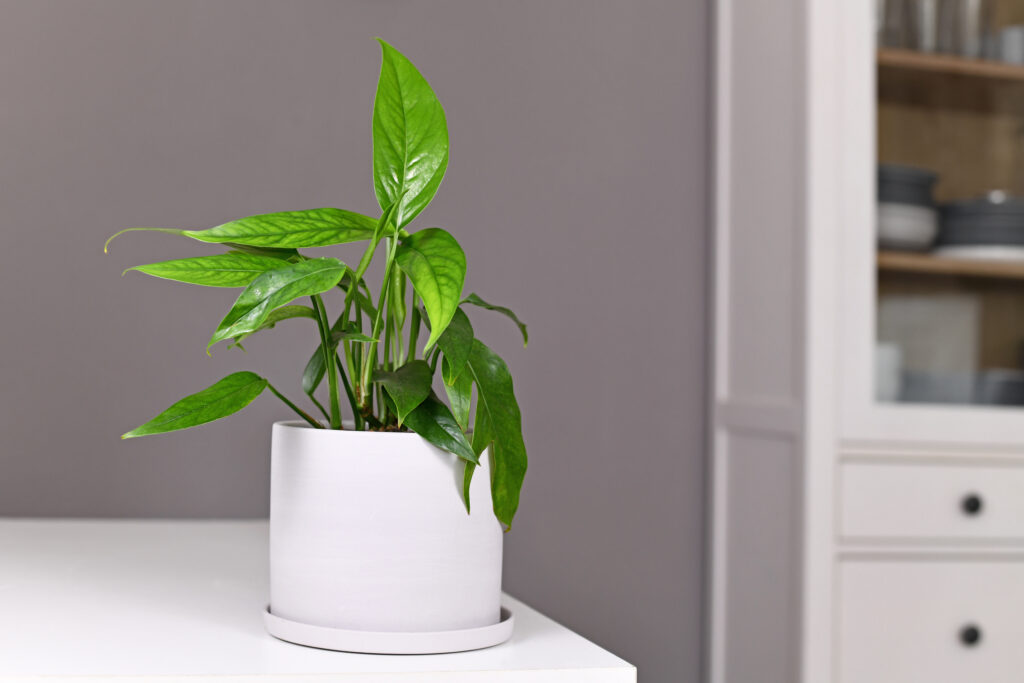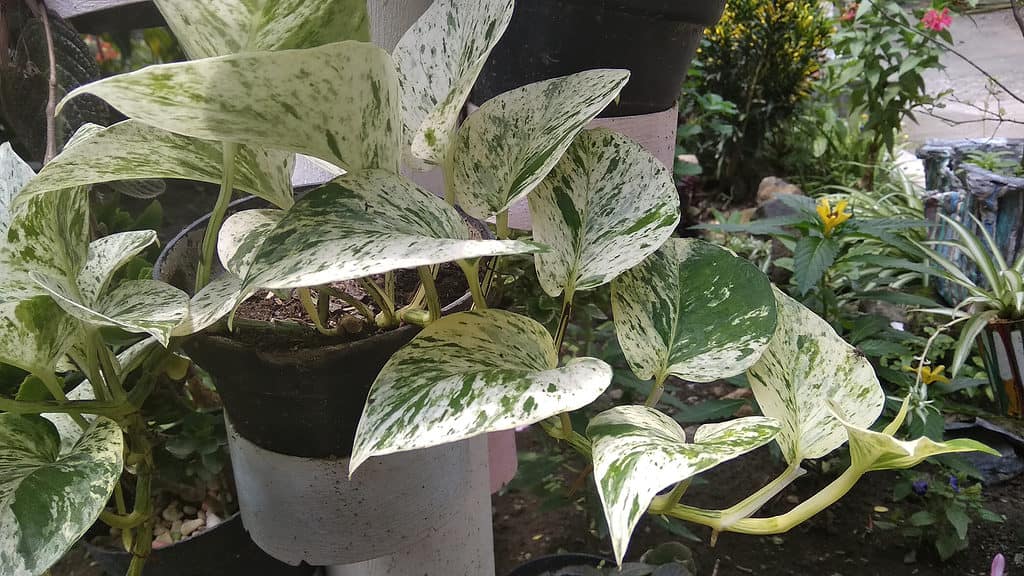Pothos are excellent indoor houseplants due to their ease of care and their generally stunning looks. However, did you know there are actually multiple species of pothos? Many of us are familiar with the common golden pothos and its many variegated and non-variegated varieties. However, there is another species of pothos that has also become very popular in the plant trade: the dragon’s tail pothos, also known as the species Epipremnum pinnatum.
So how does this species of pothos stack up against one of the most popular variegated varieties of Epipremnum aureum known as the marble queen? In this guide, we’ll compare these two popular houseplants, outline their differences, and explore how to grow your own plants at home with ease.
Comparing Dragon’s Tail Pothos vs. Marble Queen Pothos
| Dragon’s Tail Pothos | Marble Queen Pothos | |
|---|---|---|
| Classification | Epipremnum pinnatum | Epipremnum aureum ‘Marble Queen’ |
| Alternative Names | Centipede Tongavine, Taro Vine, Silver Vine | N/A |
| Origin | South Pacific Islands, Southern Asia, Tropical Australia | South Pacific Islands |
| Description | An evergreening climbing or vining plant with long, scale-like green leaves. | A variety or cultivar of variegated pothos that has extremely white marbled patterns on its leaves. |
| Uses | Ornamental Houseplant | Ornamental Houseplant |
| Growth Tips | This species does best when its top three inches of soil are allowed to dry out completely before giving it any water. | Make sure this variety gets plenty of sunlight, as its variegated leaves lack the normal amount of chlorophyll. |
| Interesting Features | This plant’s long and oval teardrop leaves resemble reptile scales, hence its name. | The leaves of this species are heart-shaped and wide, unlike the dragon’s tail pothos. |
The Key Differences Between Dragon’s Tail Pothos and Marble Queen Pothos
There are many differences between the dragon’s tail pothos and the marble queen pothos. To start, the dragon’s tail pothos is of the species Epipremnum pinnatum. The marble queen pothos is a variety of the species Epipremnum aureum. They both share the same genus but are nonetheless completely different species of plants.
Another big difference that one might notice between these two plants is their leaf shapes. The dragon’s tail pothos as longer, thinner, more scale-shaped leaves. The marble queen pothos has the traditional heart-shaped, almost round leaves that are common among golden pothos varieties and cultivars.
There are some pretty big differences between these plants’ color and variegation. The common dragon’s tail pothos is not variegated, meaning it does not have any additional colors or patterns on its leaves. Rather, it has solid golden-green or dark-green leaves. That’s not to say this species doesn’t have variegated varieties and cultivars of its own, though. The Cebu blue pothos is one example of a lovely pale variegated dragon’s tail pothos. That being said, we’re comparing the marble queen pothos to the common dragon’s tail. Where the common dragon’s tail pothos is solid green, the marble queen pothos has very rich, unique patterns on its leaves. The white markings and patterns on the marble queen have a marbling effect (hence its name). The white or pale green parts of the marble queen pothos’ leaves lack chlorophyll, so this plant needs a bit more sunshine than the dragon’s tail pothos in order to keep up its colorful patterns.
While the differences end there, the care requirements and general growth needs of both of these plants are generally the same. Plants from the Epipremnum genus are tropical plants that need lots of humidity, dappled sunlight, mild temperatures, and plenty of water.

The dragon’s tail pothos (pictured) is well-known for its long, sharp leaves that contrast the common golden pothos.
©iStock.com/Firn
Dragon’s Tail Pothos vs. Marble Queen Pothos: Classification
The dragon’s tail pothos has been classified as Epipremnum pinnatum. The marble queen pothos has been classified as Epipremnum aureum ‘Marble Queen’. Both plants are members of the Epipremnum genus and are closely related to one another, as well as the silver streak plant, the rengut plant, and a few other species.
Dragon’s Tail Pothos vs. Marble Queen Pothos: Description
Due to its simplicity of care and intriguing leaves that resemble a dragon tail, the dragon’s tail pothos, also known as the centipede tongavine, is a unique and highly sought-after plant. The immature leaves of the dragon’s tail plant are elongated, with a smooth edge and a pointed end. Its common name comes from the fact that as it gets older, the plant’s leaves have deep lobed surfaces that resemble a dragon’s tail. The undersides of the glossy, dark-green leaves on the dragon’s tail pothos are lighter in hue. When grown, they can reach a length of 10 feet in the wild. This plant is a climber and uses aerial roots to propel itself upward along tree trunks and other structures. Along the soil’s surface, it can also creep and be used as ground cover. The dragon’s tail pothos can be grown either in a hanging basket, where the stems and leaves can gracefully fall downward or with climbing support, such as a moss pole or virtually any grippable surface. Dragon’s tail pothos is not a Philodendron, despite the fact that it is occasionally referred to as such. It is a member of the genus Epipremnum.
The marble queen pothos is a common and very sought-after cultivar of the golden pothos. You won’t find many other houseplants with their beautifully variegated leaves, which include white and green specks. In ideal circumstances, the marble queen pothos grows quickly and can grow to a length of nearly five feet or even longer in the wild. For those who are interested, these plants are an excellent introduction to the world of collecting houseplants because they are not picky or difficult to care for while still having high degrees of variegation. Similar to other popular pothos cultivars, the marble queen pothos thrives indoors and is adaptable to a variety of growth environments, making it a great choice for novices.
Dragon’s Tail Pothos vs. Marble Queen Pothos: Uses
Both of these plants are primarily used for landscaping purposes in tropical climates and as houseplants around the world. Other than looking pretty, these plants don’t really serve any other purpose. They have both been found to be excellent air purifiers for indoor spaces, though it would take dozens if not hundreds of plants to see any real difference inside the average home.
Dragon’s Tail Pothos vs. Marble Queen Pothos: Origin
The dragon’s tail pothos is native to a number of places, such as the Southern Pacific Island, most parts of southern Asia, Australia, and New Guinea. The species has since been naturalized in tropical regions around the world, such as the West Indies and Hawaii.
The golden pothos is native to the South Pacific and French Polynesia. However, the marble queen pothos specifically is not native to any one place, as the plant itself was created by a breeder that likely used a number of gene mutations that are naturally occurring. Some will say that the marble queen can actually be found on occasion in nature. When it comes down to it, it is not incredibly clear where this cultivar originated, though we do know it has been in the plant trade since the 1950s.

The marble queen pothos (pictured) has mysterious origins, but is nonetheless easy to find in nurseries around the world.
©Rezqiano/Shutterstock.com
Dragon’s Tail Pothos vs. Marble Queen Pothos: How to Grow
The dragon’s tail pothos thrives in humid temperatures, rich and well-drained soil, and medium to bright indirect light away from direct sunshine. It also benefits from monthly feeding. When it gets pot-bound, this plant will need to be transplanted. Pruning must be done on a regular basis to keep up the plant’s appearance and stimulate new development.
During the growth season, water your dragon’s tail pothos often, letting the top three inches of soil dry out in between applications to maintain a reasonable moisture level. Although growth is modest during the winter season, watering should be decreased to maintain the right moisture amount in the soil.
The ideal temperature for the dragon’s tail pothos is between 60 and 80 degrees F. The plant does best in a temperature setting that is generally comfortable for humans. Avoid placing the dragon’s tail pothos near air conditioners, drafty windows, or radiators since they might cause leaves to fall. Normal room humidity is suitable for growing dragon tail plants. But, if the air is excessively dry, the plant’s leaf tips will turn brown and shrivel. Use a cool mist humidifier or place the pot on a tray of wet pebbles to increase humidity.
Care requirements are quite similar for the marble queen pothos. More than for other houseplants, light is crucial to the development of a robust and healthy marble queen pothos. This is a result of the leaves’ variegation. Its huge patches of white leaves cannot produce enough chlorophyll to engage in photosynthetic activity. Your plant will require all the help it can receive to develop well and ultimately survive without a normal amount of photosynthesis. To keep this plant’s gorgeous variegation, give your marble queen pothos a full day of strong indirect light close to a window. If you don’t do this, you will see that the leaves have started to become green and are unable to change back to their original hue. To avoid scorching the leaves and creating brown spots on the parts exposed to the light source, they shouldn’t be put in the harsh direct sun during the middle of the day.
Your marble queen pothos will grow best when routinely and consistently watered, despite the fact that they are not particularly thirsty plants. The proper timing will vary depending on the seasonal changes and the environmental factors surrounding your plant.
The common pothos plant is said to have originated in French Polynesia’s tropical jungles. They enjoy high relative humidity; often, their natural habitats have humidity levels of up to 90%. Fortunately, they are tolerant plants that can acclimate to a variety of interior environments with normal humidity levels of around 50%.
Dragon’s Tail Pothos vs. Marble Queen Pothos: Protections and Conservation
Neither of these plant species is endangered or of any concern in terms of availability. However, both of these species are considered invasive. In places where they have been naturalized in tropical areas, both species are considered invasive due to their fast-growing speed and ability to suffocate vegetation. A few places where these species are considered invasive include Hawaii, Puerto Rico, the Galapagos Islands, Tanzania, and more.
Both the dragon’s tail pothos and the marble queen pothos make excellent houseplants. While the marble queen will need a bit more sun to ensure it preserves its unique coloration, both of these plants are incredibly easy to grow and care for, even for the novice houseplant owner.
Want to learn more about the eye-catching pothos houseplant? Check out our in-depth guide to everything you need to know about pothos!
The photo featured at the top of this post is ©
FAQs (Frequently Asked Questions)
What does dragon's tail pothos look like?
While this variety does not have variegation, it does boast a slim, long leaf in a beautiful green hue.
Are dragon's tail pothos rare?
Dragon’s tail pothos might be hard to find, but one should be able to find one of these plants online.
What do dragon's tail pothos need to survive?
Dragon’s tail pothos simply needs bright indirect sunlight, regular watering, and occasional fertilizing treatments.
Thank you for reading! Have some feedback for us? Contact the AZ Animals editorial team.






